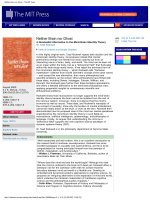the mit press americas environmental report card are we making the grade dec 2004
Bạn đang xem bản rút gọn của tài liệu. Xem và tải ngay bản đầy đủ của tài liệu tại đây (7.82 MB, 295 trang )
USES WATER RESPONSIBLY
PRACTICES FLOOD CONTROL
SAFELY DISPOSES OF GARBAGE
PROTECTS THE SOIL
PRACTICES ENERGY CONSERVATION
TRIES TO STOP GLOBAL WARMING
WORKS TO END AIR POLLUTION
TAKES STEPS TO SAVE OZONE LAYER
SAFELY STORES NUCLEAR WASTE
OVERALL EVALUATION
B-
C
B
C
D
D
B
A-
C-
C
AMERICA’S
ENVIRONMENTAL
REPORT CARD
ARE WE MAKING
THE GRADE?
Harvey Blatt
America’s Environmental Report Card
© Reprinted with permission of King Features Syndicate.
Harvey Blatt
The MIT Press
Cambridge, Massachusetts
London, England
America’s Environmental Report Card
Are We Making the Grade?
©2005 Massachusetts Institute of Technology
All rights reserved. No part of this book may be reproduced in any form by any
electronic or mechanical means (including photocopying, recording, or informa-
tion storage and retrieval) without permission in writing from the publisher.
MIT Press books may be purchased at special quantity discounts for business or
sales promotional use. For information, please e-mail special_sales@mitpress
.mit.edu or write to Special Sales Department, The MIT Press, 5 Cambridge Cen-
ter, Cambridge, MA 02142.
This book was set in Sabon by Graphic Composition, Inc.
Printed and bound in the United States of America.
Library of Congress Cataloging-in-Publication Data
Blatt, Harvey.
America’s environmental report card : are we making the grade? / Harvey Blatt.
p. cm.
Includes bibliographical references and index.
ISBN 0-262-02572-8 (alk. paper)
1. United States—Environmental conditions. 2. Pollution—United States.
I. Title.
GE150.B58 2004
363.7'00973—dc22
2004040261
10 9 8 7 6 5 4 3 2 1
Preface vii
Introduction ix
1Water: Is There Enough and Is It Drinkable? 1
2 Floods: Too Much Water 33
3 Garbage: The Smelly Mountain 51
4 Soil, Crops, and Food 71
5 Energy Supplies 95
6 Global Warming: The Climate Is Changing 127
7 Air Pollution and Your Lungs 155
8 Skin Cancer and the Ozone Hole 177
9Nuclear-Waste Disposal: Not in My Backyard 195
Conclusion 219
Appendix A: Sustainable Energy Coalition 239
Notes 247
Additional Readings 261
Index 271
Contents
1
10
—Lakota Sioux proverb
I am located in Israel, and you may wonder why a foreign-based scientist
would be writing about America’s environment. Good question with a
simple answer. I am a relative newcomer to Israel, having moved here from
my lifelong home in America in 1994 after retiring from decades of teach-
ing geology in American universities. One of my concerns as an American
had been the nation’s health, both figuratively and literally: figuratively in
terms of dwindling oil and gas supplies and its effect on America’s eco-
nomic health, and literally in terms of the effects of pollution by oil and
gas on human health.
Since coming to Israel, my environmental interests have broadened be-
cause of this country’s chronic water shortages, pollution problems, lack
of landfill space, agricultural difficulties, predicted increased aridity be-
cause of global warming, and relative nearness to Chernobyl. Israel was
upwind from Chernobyl and suffered no ill effects from that disaster, but
it certainly spiked my interest in the effects of radiation on living organ-
isms. However, the focus in this book is on America’s problems. I am still
more familiar with these and feel I might be able to help its citizens under-
stand the causes and possible solutions to the nation’s environmental ills.
As the seventeenth-century cleric/poet John Donne said, “No man is an
island,” and this certainly applies to the publishing of books. The list of
people who are part of the process includes the author, numerous manu-
script reviewers, several types of editors, designers, and production people
at the publishing house, and last but certainly not least, you the reader.
Preface
Without readers, the publishing of books would wither. So this book is
dedicated to you, the reader, in the hope you will find its contents inter-
esting and useful. I hope you will feel better informed about America’s en-
vironmental difficulties when you finish it.
Harvey Blatt
Jerusalem, Israel
viii Preface
Environmentalists make terrible neighbors but great ancestors.
—David Brower
America’s environment is in danger. According to public opinion polls
there is rising concern about many kinds of environmental deterioration.
High on the public’s list are water pollution, toxic waste, air pollution,
global warming, and radiation from nuclear power plants (particularly af-
ter Chernobyl). In a Gallup Poll in 2001, 75 to 81 percent favored setting
higher emission and pollution standards for business and industry, setting
higher auto emission standards for cars, more strongly enforcing federal
environmental regulations, and spending more federal money on develop-
ing solar and wind power. A majority were opposed to expanding the use
of nuclear energy. Protecting the environment was given priority over eco-
nomic growth, 57 percent to 33 percent. The public’s wishes are clear. But
they are not optimistic about their desires being fulfilled. In 2000, 72 per-
cent of public school parents polled believed the environment would be-
come dirtier during their child’s lifetime. An astonishing 95 percent of all
adults want environmental education taught in our K-12 schools. The in-
tensity of the American public’s concern about environmental deteriora-
tion is perhaps best shown by a 2002 Gallup poll that indicated 63 percent
of us would even be willing to roll back President George W. Bush’s 2002
tax cuts to protect the environment. Now that’s real concern!
The scientific community is also concerned about our incessant down-
grading of the environment. However, the public and the scientific com-
munity do not always agree on which deteriorations are most serious. Part
of the disagreement stems from how we define risk. Scientists, engineers,
Introduction
and other experts in the evaluation of hazards tend to use and interpret the
term risk in a narrow actuarial sense—that is, as average annual mortality
rates for the population. How many people are killed each year in floods?
By how many years is the average American’s life shortened by air pollu-
tion? What are the chances of getting cancer from an average lifetime num-
ber of X-rays by your doctor (1 in 700, between 0.1 and 0.2 percent)?
The public, on the other hand, commonly interprets risk in a very per-
sonal way, depending on whether they believe that they or their families
are exposed. If you live along the Mississippi River, floods are a continual
environmental concern for you and your family (about 110 people are
killed each year). But if you reside in Nevada, the storage by the federal
government of highly radioactive nuclear waste at Yucca Mountain is a
much more pressing concern. We are all concerned about data suggesting
that toxic agents in the environment have reduced the average male sperm
count by 42 percent in the past 50 years and that estrogen-mimicking
chemicals in drinking water can have a feminizing effect on organisms.
Clearly, the concerns of the scientist and the public overlap. For example,
both groups are concerned about the dangers of medical X-rays.
Can you believe what I say in this book? I hope so. A poll to determine
who the public believes as sources of information revealed an extraordinary
lack of trust in the objectivity of evaluations by the government, industry,
media, trade unions, and religious organizations, which are widely per-
ceived as having “an ax to grind,” but scientists and environmentalists fared
much better. However, friends and family members were considered almost
50 percent more believable than scientists (figure I.1). Unfortunately, your
friends and close relatives will probably not write a book like this.
The topics we will consider in this book take into account both the sci-
entists’ concerns based on their actuarial way of thinking and the more
personal evaluations of the general public. We will deal with water pollu-
tion in chapters 1 through 4, which treat water supply and pollution, flood
dangers, water pollution by buried garbage in our town’s landfill, and pes-
ticide runoff in irrigation water from farms. The ways we generate the en-
ergy that powers our industrial society are explained in chapter 5, and the
resultant global warming is discussed in chapter 6, which deals with car-
bon dioxide and the other heat-trapping gases emitted from our factories
and cars. Chapter 7 is concerned with another result of the sources of en-
x Introduction
ergy we use, the filth in the air we breathe. The importance of ozone, its re-
lationship to skin cancer, and the disastrous development of the “ozone
hole” are dealt with in chapter 8. A lengthy chapter 9 is concerned with
the problems of nuclear energy and the storage of its radioactive by-
products. In chapter 10 I try to chart a realistic path to a sustainable fu-
ture, one with enough water, clean and abundant soil, clean sources of
energy, a stable climate, and pollution-free air.
I have tried to make the topics discussed in the book as accessible as pos-
sible. The tone is conversational, I have tried to sprinkle humor and enter-
taining anecdotes throughout the text, and I have included citations in
each chapter so the reader can check my statements against statements by
professionals in each field.
The environmental topics discussed in this book are those that I believe
are viewed as most important to most Americans at the present time. There
are others that I considered, such as the ever-increasing noise pollution that
Introduction xi
Figure I.1
Whom do you believe? (C. Marris and I. Langford, Who Do We Trust? New Scien-
tist, September 28, 1996, p. 38). Reprinted with permission of New Scientist.
has damaged the hearing of many, perhaps most, Americans. The ongoing
decimation of ecologically sound forests and their artificial replacement by
fast-growing pine trees is another serious problem. The plundering of
nearshore oceanic fisheries is an international disgrace that, if not stopped
soon, may have disastrous effects on our food supply. Loss of biodiversity
is a topic of worldwide concern. Desertification is a growing problem in
some regions. Overpopulation is a growing concern. The list of insults to
the environment is endless, but a line had to be drawn somewhere to pre-
vent the book from becoming an encyclopedia.
Many of our environmental problems exist because for the first 80 per-
cent of America’s history the Europeans who settled here purposefully
modified the environment for their needs with not enough concern for the
long-term damage they were doing to the surroundings. The population
was low and new land to develop seemed never-ending. Factories were lo-
cated next to rivers, so their unwanted by-products could be dumped into
them to be carried away and out of sight. Out of sight, out of mind. Un-
fortunately they have forced their way back into our minds as pure drink-
ing water has become harder to find. Sales of bottled water have
skyrocketed, partly in response to a public perception that public water
supplies are not always safe.
Forests were believed to be so abundant that they were thought of as in-
destructible and were decimated to provide clear areas for farming and
wood for houses and factories. Who thought that tree cutting increased
flooding? The record-setting disastrous floods that hit the Midwestern
part of the country in 1993 drew our attention to the need for costly dis-
aster relief for millions of Americans. We all pay for this relief through our
tax dollars.
What about the incredible volumes of garbage we produce? Take, for
example, plastics. A glance almost anywhere in the modern world reveals
that plastics are everywhere. Perusal of supermarket shelves, automobile
bodies, styrofoam cups, or racks in dry-cleaning establishments reveals
how indispensable these petroleum-based products have become. What
happens to empty plastic soda bottles, car bumpers, or the filmy plastic
that protects our newly cleaned suits and dresses? We dump it somewhere,
usually in the trash bucket, from where it is most likely buried in a sanitary
landfill, formerly called a garbage dump. In terms of human life span, plas-
xii Introduction
tics last forever and we are running out of conveniently located, usable
dump space. What can we do?
America’s agricultural abundance is the envy of the world, which de-
pends heavily on our bounty. But this bounty is thought to have come
largely as a result of the intensive use of pesticides that cause harm to us
and other living things, as well as to the pests the chemicals are intended
to control. Can our productivity be maintained without using these chem-
icals? Can contaminated soil be cleansed? Should organic farming be the
wave of the future for American farmers? And what about genetically
modified foods? Are they safe?
The lowland areas of the East and Gulf coasts are regularly swamped by
hurricane waters, an event that may become more common as global
warming causes glaciers to melt and sea level to rise. Much of the Ameri-
can population is clustered along the Atlantic and Pacific coasts, and by
2010 the coastal population is expected to reach more than 100 million,
about one-third of all Americans. Can flooding within and at the fringes
of the United States be controlled?
The world is getting warmer and more humid, in part because of the car-
bon dioxide we continually pump into our air. The United States produces
21 percent of the fossil-fuel-related carbon dioxide entering the air each
year. How can we stop this change in our climate? The answer is clear. Stop
burning coal and oil, the sources of nearly all the carbon dioxide increase.
But can American industry survive without coal and oil? Can solar en-
ergy, wind power, and other renewable, inexhaustible, and nonpolluting
sources of power replace coal and oil? If so, how soon, and why can’t it be
done “overnight”? After all, when we and the other major industrialized
countries recognized that chemicals called chlorofluorocarbons (CFCs)
were destroying our ozone shield about 20 years ago, we agreed to phase
out their production and found substitutes. Can we do this with coal and
oil?
Each day each of us inhales about 2,500 gallons of air. Along with the
air we also suck in fumes from automobile exhaust, smog, lead, asbestos,
and microscopic pieces of the rubber tires on our cars. The tread disap-
pears into your lungs and accumulates there. No place on earth has pure,
clean air nowadays. Some places are better off than others, however.
Where are these places, and why is their air better than it is where most
Introduction xiii
Americans live? Can dirty air be cleansed and how? Should the govern-
ment tax those who breathe clean air to finance cleaning up the lungs of
citizens who suffer from air pollution?
These are some of the many environmental problems Americans are
now being asked to think about and do something about. Some of our ac-
tions must be as individuals. We can use less water without feeling the
pinch. So can farmers. The amount of plastic wrapping on the products in
American stores is a national scandal and can painlessly be reduced. Wrap-
ping can be a factor in our purchasing decisions without it causing dam-
age to the products we want. People can choose not to build in flood-prone
areas.
Some of our actions must be corporate. Surely laws can be passed to pre-
vent the dumping of poisons into the water supply without destroying
American industry. Genetic engineering and organic farming hold the
promise of a largely pesticide-free agriculture. Communities can vote for
small increases in their utility bills to help finance construction of pollu-
tion-free energy sources. Our future environment is in our hands. We have
permitted this pollution to occur, and we can stop it if we choose to. In the
chapters to follow we will consider our major environmental problems
and discuss possible ways of solving them. And they must be solved even-
tually. Sooner or later the water must be purified, the air must be cleansed,
and the garbage must be disposed of. The emphasis throughout will be on
workable solutions that inflict minimal hardship on us all. After all, no one
likes to sacrifice a high standard of living or abundant conveniences. Not
even the author of this book!
xiv Introduction
America’s Environmental Report Card
Water: Is There Enough and Is It Drinkable?
Men work on earth at many things;
Some till the soil, a few are kings;
But the noblest job beneath the sun
Is making Running Water run.
—John L. Ford, Water and Wastewater Engineering
Few of us think regularly about water. It seems limitless because it falls
from the sky year after year. We turn on the tap and fresh, pure water
comes out. Most of us have never known it to be otherwise. But problems
that water specialists saw on the horizon many decades ago are now with
us. Water shortages are a well-known problem not only in desert areas
such as Tucson, Phoenix, Las Vegas, and Albuquerque but also in moister
places like New York City. As America’s population continues to grow at
its current rate of 3 million each year, water shortages will creep into other
large cities as well. Adding to the water problems caused by increasing
numbers is the increasing concentration of our population in cities. The
nation’s population is increasing about 1 percent per year and the growth
of cities is much faster. About three-quarters of all Americans now live in
large cities. That is where most jobs and growth opportunities are.
Perhaps even more frightening than the looming shortage of water is the
amount of impure water we are drinking. Despite marked improvement
since passage of the Clean Water Act 35 years ago, the United Nations es-
timates that 5.6 million Americans (2 percent of us) drink water that does
not meet safety standards. Chemical contaminants are present in all our
major streams and in 90 percent of our underground aquifers. Twenty-
four percent of Americans refuse to drink tap water. Sixty-five percent take
such precautions as treating water in their homes by filtering or boiling it.
More than half of us drink bottled water despite a 1997 UN study that
showed bottled water was in no way superior to New York City tap wa-
ter. And the Natural Resources Defense Council in 1999 estimated that at
least 25 percent of bottled water is in fact ordinary tap water. One bottled-
water supplier was found to be drawing its water from a well in the middle
of an industrial parking lot next to a hazardous waste site!
1
There probably is more than one reason more than half of all Americans
drink bottled water. Not only suspicions about our city’s water may be in-
volved. Thanks to advertising, there is a certain cachet or possibly snob
appeal to imbibing a glass of Perrier or Evian imported from France rather
than the liquid the city supplies. But whatever the reason, bottled water is
the fastest-growing major beverage category in America. On average, each
of us in 2000 drank 53 gallons of bottled water (table 1.1). Sales have in-
creased ninefold in the past 20 years, tripled in the last 10, and increased
30 percent between 2000 and 2001 and 11 percent more in 2002, despite
the fact that bottled water costs 120 to 7,500 times more than tap water
and 6 times more than gasoline.
Even our treasured pets can enjoy the thrill of bottled water designed es-
pecially for them. The K9 Water Company in California (of course, where
else?) sells beef-, liver-, chicken-, and lamb-flavored bottled water for dogs.
You can even get all four in a combo pack “so your dog can decide . . . ”
2 Chapter 1
Table 1.1
Beverages Americans drink in gallons per year (International Bottled Water
Association)
Water 140
Tap 87
Bottled 53
Carbonated soda 59
Coffee 46
Juice 43
Milk 39
Tea 27
Alcoholic drinks 23
New age beverages 14
Sports drinks 11
TOTAL 402
Pollution from farms, factories, and even the pipes that bring the water
to our homes is increasing. Underground water supplies in about half the
states have been contaminated with hazardous wastewater legally injected
into it. The wastewater came from chemical plants and other industrial
sources that produce materials essential to the way we live.
Lead in drinking water is a problem in many major cities, including Chi-
cago, San Francisco, Boston, New York, and Washington, our nation’s cap-
ital. Water pipes in buildings built before 1960 were made of lead, and lead
solder to seal water pipes was in use until 1988. It is uncertain how many
Americans have health maladies caused by ingesting lead. Lead causes brain
damage, among other maladies, but we do not know whether the lead in
Washington’s drinking water, where 16 percent of the water pipes are made
of lead, has affected legislative judgment in recent Congresses. The way we
waste and contaminate our water supplies has generated a new word—
hydrocide, patterned after the more familiar word suicide.
The Water Cycle
The journey of water is round, and its loss, too, moves in a circle, following us
around the world as we lose something of such immense value that we do not yet
even know its name.
—Linda Hogan, Northern Lights
Most of America’s large cities use surface water. The amount of surface
water available to each American for all purposes (personal, industrial,
agricultural, and so on) from rainfall, rivers, and lakes is 138,000 gallons
per day. This number is the result of a system of water circulation known
as the water cycle. Pure water is evaporated from the salty ocean, is car-
ried by winds over the land surface, and as air temperatures and land ele-
vations change, the moisture is dropped from the air onto a thirsty
population. Most of this moisture falls on land, runs off into streams and
rivers where it is available for our use, and eventually finds its way back
to the ocean. Some of this heaven-sent moisture is taken directly into
plants and combined with carbon dioxide gas from the air to produce
plant tissues (biomass). Some of the precipitation soaks into the soil and
continues downward hundreds or thousands of feet into empty spaces in
the underlying rocks. This becomes an underground water supply known
Water: Is There Enough and Is It Drinkable? 3
as groundwater. Some precipitation falls directly into lakes, such as the
Great Lakes that form part of the boundary between the United States and
Canada. And some of the moisture that falls to the ground evaporates back
into the moving air before it can flow into streams, enter lakes, or soak into
the ground. When all these gains and losses are totaled up each of us ends
up with a theoretical 138,000 gallons per day to spend as we see fit, for
drinking, growing crops, manufacturing steel, or flushing toilets.
The expression “each of us” is, of course, a statistical average. Obvi-
ously, some of us end up with more than others. If you live in the Western
half of the country you average less than your “fair share,” perhaps 20
inches of rain and snow a year. If you live in the Eastern half, your cup
runneth over with perhaps 40 inches a year (figure 1.1). Life is not fair.
Neither is the distribution of water. But we must deal with the world as
nature provides it. How do Americans deal with it? The answer is “very
wastefully.” All of us contribute to the national hydrocide. Consider the
following facts.
4 Chapter 1
Figure 1.1
Average annual precipitation in the United States (U.S. Water Resources Council,
1968, The Nation’s Water Resources).
•
The channel of the formerly mighty Colorado River in the Western
United States is dry when it reaches its outlet at the Gulf of California, the
result of too much removal by users upstream.
•
Water is being removed from underground reservoirs many times faster
than it is naturally replenished. Most of the withdrawals from our under-
ground water bank are for crop irrigation.
•
Water usage in the United States has increased sixfold since 1900 al-
though the population has increased less than fourfold.
•
One in five Americans drinks water from a treatment plant that violates
safety standards. Forty percent of these plants release water with danger-
ously high levels of disease-causing bacteria.
•
According to the U.S. Geological Survey, the water in 47 percent of city
wells contains toxic organic compounds. In rural areas, 14 percent of wells
contain these chemicals. Over a person’s lifetime, ingestion of these chem-
icals has adverse health effects such as cancer and reproductive problems.
Let’s look at these factors in our national hydrocide to see why we have
them and what we might do to remedy them.
The Colorado River
The first thing they noticed was that the river was no longer there. Somebody had
removed the Colorado River.
—Edward Abbey, The Monkey Wrench Gang
The dry channel at the southern end of the Colorado River is perhaps the
prime example of surface-water scarcity produced by human activities
(figure 1.2). The river originates in western Colorado, then flows through
southeastern Utah and along the boundary between California and Ari-
zona before entering Mexico and spilling into the Gulf of California. Ac-
tually, the word spilling is inaccurate, because the river channel is dry at
its contact with the Gulf. Humans are to blame. The Colorado River is
among the most heavily plumbed rivers in the world, providing water for
30 million people, one-tenth of the American population.
The region through which the river flows is semiarid, with an annual
precipitation of only 15 inches, and nearly 90 percent of this moisture
evaporates before reaching the river channel. Even so, the average volume
Water: Is There Enough and Is It Drinkable? 5
Figure 1.2
Drainage area served by the Colorado River and the dams constructed to minimize
annual variations in rainfall.
6 Chapter 1
of water carried by the river is more than 15 million acre-feet per year. (An
acre-foot is an area of 1 acre covered with water to a depth of 1 foot; about
325,000 gallons of water, enough to supply the water needs of a family of
5 for 1 year.) You would think that 5 trillion gallons of water a year (15
million × 325,000) would be enough to keep people happy. And it was,
until the increase in the number of people in southern California in the first
half of the twentieth century and the growth of Las Vegas, Phoenix, and
Tucson in the last half.
The influx of people to California and Arizona quickly generated water
problems. Southern Californians wanted to transport Colorado River wa-
ter westward to supplement the inadequate amount of precipitation that
nature supplies to Los Angeles, about 15 inches per year. Phoenix, with
only 8 inches of rainfall a year but with a climate that appeals to retirees
from the frigid Northeast, also wanted Colorado River water. And there
was a growing agricultural base in central Arizona that depended on wa-
ter for irrigation. Also wanting more water after World War II was arid
Las Vegas, with only 4 inches of rain per year. This city’s heady mixture of
gambling and prostitution stimulated its growth from a small community
in 1950 to its position today as one of America’s fastest-growing metro-
politan areas, with a population of 1,500,000.
What should be done? Who owns the water, anyway? Legal battles over
the ownership of Colorado River water brew continuously among the
states that border the river and also between the United States and Mex-
ico, because the water has been overappropriated. More water has been
allocated to the states than the river can supply. Problems began in 1922
when an agreement called the Colorado River Compact divided the river
into an upper and a lower part. Wyoming, Colorado, Utah, and New
Mexico were to share the water of the upper part of the drainage area, and
Nevada, Arizona, and California were to share the lower-basin water. The
users of each part were allocated 7.5 million acre-feet per year, half the av-
erage yearly flow of 15 million acre-feet. In 1922 the yearly flow was
higher than normal at about 20 million acre-feet, a heady surplus. This
agreement among the states was followed in 1945 by a treaty with Mex-
ico that allocated our southern neighbor a minimum of 1.5 million acre-
feet per year. Hence, more water was allocated in these two agreements
than the river contains in an average year.
Water: Is There Enough and Is It Drinkable? 7
As we know, an average is a central value around which there is varia-
tion. In rainy years river flow will exceed the 15 million acre-feet average;
in dry years it will be less. Recall that the treaties allocated acre-feet of wa-
ter to the contestants, not percentages; the allocation was 7.5 million acre-
feet, not 50 percent of the annual flow. Since 1922 or 1945 there have been
many years of less-than-average flow. In 1934 flow was less than 5 million
acre-feet; in 1940 it was 7 million; and in 1963 and 1964 flow was a mi-
nuscule 3 million acre-feet. We have entered lawyers’ heaven.
The method chosen to circumvent these unfortunate allocations was to
build dams along the river, which would store water during wet years and
release it during dry years. This would smooth out the yearly variations in
river flow. There are now ten major dams along the Colorado River. Ob-
viously, the dams could not change the predam average yearly flow of 15
million acre-feet. They could only make the yearly variations in rainfall
less traumatic.
The phenomenal population growth in southern California, Arizona, and
southern Nevada has drawn increasing attention to the inadequacy of the
water supply in this region. Colorado River water provides for the house-
holds of tens of millions of people, fills swimming pools and sprinkles green
lawns in Los Angeles, powers neon lights in Las Vegas casinos, and irrigates
2 million acres of farmland in southern California, southern Arizona, and
northern Mexico. Turbines in the dams also generate nearly 12 billion
kilowatt-hours of electricity annually. There is no long-term solution to the
problem of inadequate surface water for the burgeoning population in this
area of the United States.
Subsurface Water
Humans build their societies around consumption of fossil water long buried in
the earth, and these societies, being based on temporary resources, face the prob-
lem of being temporary themselves.
—Charles Bowden
What about water located underground? More than half the U.S. popula-
tion depends on subsurface water as their primary source of drinking wa-
ter. It has been estimated that the amount of freshwater contained in rocks
below the ground, estimated to be 33 quadrillion (33,000,000,000,000,000)
8 Chapter 1









